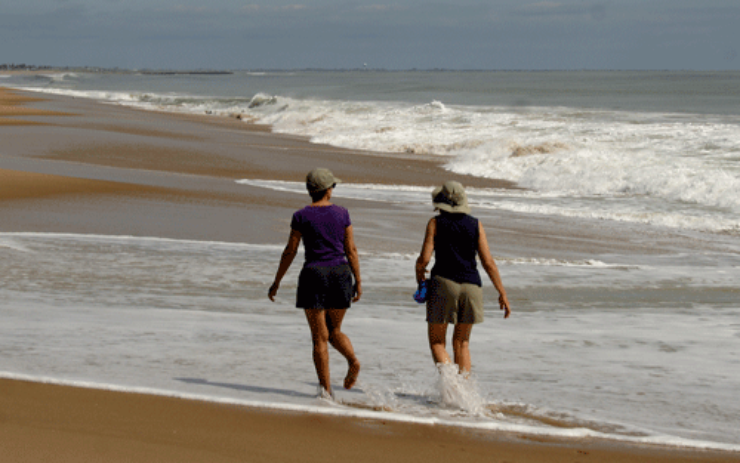Ruth Platner: Shoreline Access
With the recent arrest and then release of a beach goer in South Kingstown for trespass at what he believed was the mean high tide line, the issue of coastal access is in the news.
Article I, Section 17 of the Rhode Island Constitution gives all the people the right to walk along the shore and other privileges.
The people shall continue to enjoy and freely exercise all the rights of fishery, and the privileges of the shore, to which they have been heretofore entitled under the charter and usages of this state, including but not limited to fishing from the shore, the gathering of seaweed, leaving the shore to swim in the sea and passage along the shore; and they shall be secure in their rights to the use and enjoyment of the natural resources of the state with due regard for the preservation of their values; and it shall be the duty of the general assembly to provide for the conservation of the air, land, water, plant, animal, mineral and other natural resources of the state, and to adopt all means necessary and proper by law to protect the natural environment of the people of the state by providing adequate resource planning for the control and regulation of the use of the natural resources of the state and for the preservation, regeneration and restoration of the natural environment of the state.
The second half of this section is about the legislature’s responsibility to protect natural resources. With the exception of a few such as our own State Representative Blake Filippi, the general assembly hasn’t done a great job in recent years of protecting natural resources. They have, for instance, passed legislation that makes it harder for local communities to protect wetlands and other resources. So it’s hard to know how vigorously they will defend the first half of this section that guarantees access to the shore.
There is no doubt where Charlestown’s State Representative Blake Filippi stands, as he is sharing Article I, Section 17 of the Rhode Island Constitution at his Facebook page as “This summer’s must have for all beach goers:”
Rhode Islanders’ rights to the shore are clear, but what is less clear is where exactly you get to enjoy those rights.
According to the Coastal Resources Management Council (CRMC), “In Rhode Island, the public has the right to access the beach seaward of the mean high water mark (mean high tide is seaward of the seaweed line and where the beach gets wet on any given day). Confusion exists because the mean high water is not the same as the high tide mark. In actuality, mean high water, as determined by the Ibbison case, is much further seaward than most think. This is confusing because under the State Constitution, Article 1, Sect. 17, the public has the right to lateral access without mention of this difference. The activities that are allowed under this law are, by implication, activities that take place above the mean high tide line.”
The Ibbison case mentioned above in the quote from CRMC involved people in a volunteer beach cleanup being charged with trespass. The volunteers were passing below the high tide mark, but above where a property owner had staked out the mean-high-water line. ” Also, at the time of the arrest, the mean-high-tide line was under water.” The Ibbison case sets the public land as seaward of the mean high tide, but then dismissed the charges because ” basic due process provides that no man shall be held criminally responsible for conduct that he could not reasonably understand to be proscribed.”
The Ibbison case states in “the future, any municipality that intends to impose criminal penalties for trespass on waterfront property above the mean-high-tide line must prove beyond reasonable doubt that the defendant knew the location of the boundary line and intentionally trespassed across it.”
Legislation has been introduced over the years to clarify beach access. Legislation in 2006 that would have provided the right to walk along a 10-foot wide strip of dry-sand beach passed the House, but not the Senate. Legislation that provides a clear and easily measurable line of where public access starts would help everyone. Just landward of the seaweed line might be a good place to start.

You can learn more about the author, Ruth Platner, at her profile page.

June 15, 2019 @ 3:44 pm
I don’t think I want to wade into this discussion. There re too many variables in play; not enough data to produce a definitive answer; and just when you think you have the answer, sea level rise and salt water intrusion will wipe out your solution.
June 15, 2019 @ 10:33 am
Very informative article that ALL Rhode Islanders should read and exercise their access rights. This ambiguity must be corrected in no uncertain terms. This calls for immediate attention to get the bill passed. Who do these property owners think they are in denying this right, I hope they enjoy July 6th.
June 14, 2019 @ 9:40 pm
Just read the entire article. Wow. The home owners hired a security guard. What’s up with that?
Should be a hot, steamy beach summer. Forget beach yoga, put on those boxing gloves.
?Why did he get arrested by So. Kingstown police and not Charlestown? Photo shows Charlestown homes. Confused on that one. Not sorry I did not buy a beach pass this year.
On the morning of July 6, Keeley is planning a demonstration on that same strip of land, inviting people to walk, swim, fish, gather seaweed, and calmly, civilly protest. It is something of a line in the sand, moving farther inland than before.
June 14, 2019 @ 11:38 am
Is there a list of beach access places in Charlestown? If yes where is it? If no could the town council or the Parks and Rec Dept or someone generate a list with addresses and a map, and make it easily available?
Could a sign be put up at each access point describing the public’s rights?
June 14, 2019 @ 12:18 pm
CRMC has a list for the state in their “Public Access to the Rhode Island Coast“. Charlestown is pages 23 and 24.
June 14, 2019 @ 8:29 am
I find this ambiguous. Why not a marker that would clarify this. Also, to the right of the Charlestown Town Beach access, a property owner has put up ropes and signs that say “private beach.”. Who are these property owners that claim to own the beach. This is the ocean state. No other issues in my community are this incendiary.
June 14, 2019 @ 8:44 am
It is ambiguous, that’s the problem. The RI Constitution gives you rights to the shore that are generally only able to be exercised at the high water mark, the public land begins at the mean high water mark which is farther out towards, or often in, the ocean, and it is illegal to trespass on private land. The public’s rights and other laws all collide at the water’s edge. Just my opinion, but I think state legislation to clarify all this would be helpful.
June 13, 2019 @ 8:12 pm
In the time of “catastrophic” departure from climate norms as well as unprecedented coastal erosion the Ibbison Case (which was clearly already badly flawed) is even more obviously relic of the past. The Constitution clearly intends to protect the rights of the people to access the “shore”. Any legal gymnastics that first defines the Constitutionally guaranteed “shore” as statutory mean high tide, and then limits access to mean high tide even when that decision has the effect of totally eliminating access to the shore… is clearly substantially flawed. A small child can understand this.
June 13, 2019 @ 1:45 pm
Very important issue. I would be willing to get involved in activities on this subject
June 13, 2019 @ 9:56 am
Excellent piece.
June 13, 2019 @ 9:50 am
RIDEM is also mandated to conserve resources. For the past thirty years the emphasis has been placed on providing recreational experiences for fee paying citizens, at times to the detriment of the environment and the species naturally occurring there. This is the result of legislative influence.